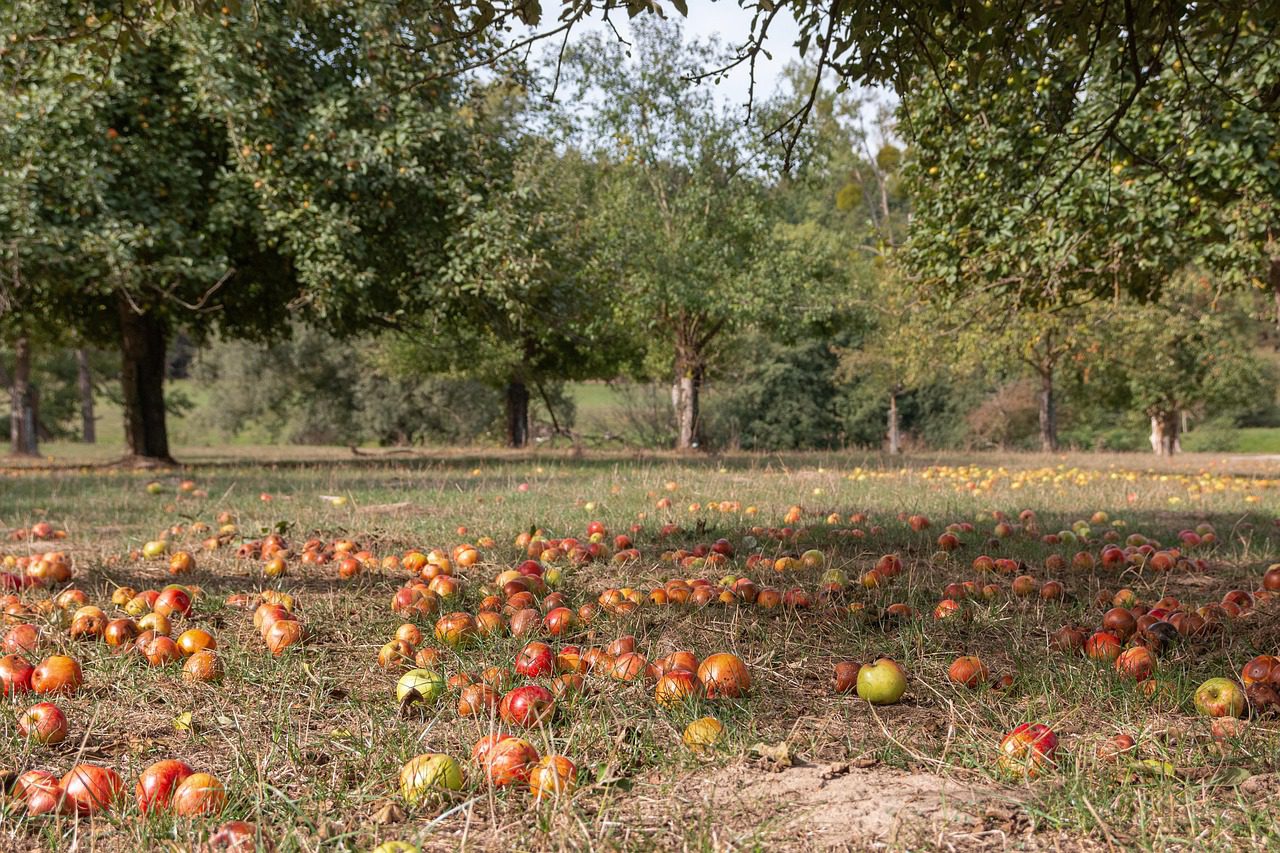Simple Steps for Greener, Healthier Harvests
Have you ever wondered if the secret to juicy, sweet fruit could be hiding in your compost bin? Compost on fruit trees isn’t just a gardening trend—it’s nature’s way of giving back.
Composting means recycling food scraps, garden waste, or even fallen leaves and letting tiny bugs and microbes turn them into a nutrient-rich soil booster.
If you’ve got fruit trees, compost matters because it feeds the soil, helps your trees grow strong, and makes your harvests healthier and tastier.
Sustainable living starts right at home. By making your own compost, whether with a basic pile, a compost tumbler, or by vermicomposting with worms, you’re turning waste into a powerful, earth-friendly resource.
Composting keeps your yard healthier, cuts landfill waste, and is easy enough for anyone to learn. Whether you’re a beginner or a composting pro, using compost on fruit trees brings bigger, better fruit and a happier, greener garden.
Key Takeaways
- Composting transforms kitchen scraps and yard waste into rich soil for fruit trees.
- It helps fruit trees grow stronger and produce better fruit using natural nutrients.
- Composting at home is easy with methods like vermicomposting or a compost tumbler.
- Making your own compost supports a more sustainable, waste-free lifestyle.
Want extra tips?
Check out the Pine needle composting guide or quick Chicken manure composting tips for more ways to boost your compost pile.
How Compost Benefits Fruit Trees
Let’s take a closer look at why compost on fruit trees is a gardener’s best friend.
Whether you’re tossing homemade compost from a compost tumbler or spreading the crumbly results of your latest vermicomposting project, compost delivers real, visible benefits to your orchard and backyard favorites.
 Photo by Greta Hoffman
Photo by Greta Hoffman
Better Soil Structure and Water Retention
Compost turns hard, tired ground into soft, spongy soil where roots can really breathe. It works a bit like a natural soil conditioner.
Adding compost on fruit trees keeps the dirt loose, making it easier for air and water to reach deep down to the roots.
Healthy soil holds onto water like a sponge, saving you time on watering and protecting your trees during dry spells.
Key ways compost improves soil:
- Makes heavy clay lighter and sandy soil firmer, creating perfect growing conditions.
- Prevents puddling and run-off by helping water soak in and stay where it’s needed.
- Boosts moisture during summer heat so your fruit trees stay hydrated and happy.
If you’re curious about the science, compost is full of tiny particles that help soil clump together just enough.
This sweet spot keeps soil from getting too compact or too loose, so tree roots can spread and grow.
For even more on how compost builds great soil, check out these soil improvement basics.
Nutrient Boost for Stronger Growth
Fruit trees are hungry growers. Compost feeds them all the essentials they need to produce leafy growth and sweet fruit.
Think of compost as a slow-release food source—nature’s own multivitamin.
Some key nutrients in compost:
- Nitrogen (N) helps fruit trees grow lots of leaves and new shoots.
- Phosphorus (P) strengthens roots and helps flowers set fruit.
- Potassium (K) boosts fruit size, sweetness, and color.
Compost also provides a mix of small nutrients (like calcium, magnesium, and trace minerals) that commercial fertilizers sometimes miss.
These nutrients come from everyday kitchen scraps, dead leaves, and grass cuttings that break down during composting or vermicomposting.
Fruit trees take up these nutrients as they need them, so you don’t have to stress about overfeeding.
Want to learn more about what these nutrients do for your trees?
The basics of fruit tree fertilizer needs are explained at Fertilizing and Compost for Fruit Trees.
Healthy Roots and Disease Resistance
Strong, deep roots are the secret to sturdy fruit trees. Compost gives roots exactly what they need: a comfortable bed that’s full of life.
Microbes in compost build up the good bacteria and fungi in the soil, which in turn help roots absorb more food and stay healthy.
How compost helps keep roots and trees healthy:
- Reduces stress by keeping soil light and root-friendly.
- Feeds important soil microbes that protect roots from harmful diseases.
- Stops soil from drying out or getting waterlogged, which can cause root rot.
- Encourages a web of tiny life that breaks down threats before they reach your tree.
If you’re new to composting, or want to explore more ways to turn waste into rich soil, try the 6 Effective Composting Methods for practical, beginner-friendly ideas.
Animal Manures for Fruit Trees: Tips and Cautions
Animal manures, like chicken manure, make fantastic compost but need a little care before spreading them around your fruit trees.
Fresh manure is too strong and can burn roots, but once it’s fully composted it gives a bonus nutrient boost—especially for heavy feeders like apples and plums.
Tips for using manure compost safely:
- Always compost animal manure thoroughly before using it on fruit trees.
- Let manure-based compost age for at least six months to a year.
- Wear gloves when handling, and never use pet or human waste.
For gardeners curious about safe ways to compost with animal manure, these chicken manure composting tips cover everything you need, from setup to spreading.
Key Takeaways
- Compost on fruit trees creates healthy, moisture-holding soil for strong, deep roots.
- Nutrient-rich compost feeds fruit trees a balanced mix of nitrogen, phosphorus, and potassium.
- Regular composting protects against root rot and other soil-borne diseases by supporting good microbes.
- Animal manures add extra nutrients but must be fully composted before use.
- Tools like a compost tumbler or vermicomposting bin make the process simple, clean, and effective.
Composting brings life back to your soil and bigger, juicier fruit to your garden—all using waste you’d usually throw away.
Simple Ways to Apply Compost on Fruit Trees
Spreading compost on fruit trees doesn’t need to be a puzzle.
With just a few simple tools and a bit of good compost—whether from a traditional pile, a compost tumbler, or even a worm bin—you’re ready to give your trees a health boost.
Here’s how anyone can apply compost the easy way for greener, stronger fruit trees that love a good feed.
Mulching and Top Dressing Techniques:
Step-by-step for Spreading Compost, Vermicompost, and Compost from Tumblers Around Tree Bases
Start with the basics: mulching and top dressing are the two easiest ways to put compost on fruit trees.
Mulch helps lock in moisture and keep weed competition low, while top dressing gets nutrients right to the tree’s roots. Here’s a step-by-step guide to keep things simple:
- Clear the area: Gently rake away grass, leaves, or old mulch from the base of your fruit tree.
- Measure your compost: For young trees, 1-2 inches of compost is plenty. Older, established trees do well with 2-4 inches.
- Spread the compost: Lay the compost in a donut shape around the tree, keeping it at least 10-15 cm (about 4-6 inches) away from the trunk to prevent rot.
- Choose your blend:
- If you use vermicompost (worm castings), mix it with regular compost for a gentle, nutrient-rich layer.
- Compost from tumblers tends to be finer and breaks down quickly, making it easy to rake in or blend with mulch.
- Mulch on top (optional): Top off with a thin layer of straw, bark, or wood chips to keep compost moist and reduce weed growth.
- Water in: If your compost is dry, give it a light watering to help settle the material and start nutrient release.
Compost spreading isn’t just for fruit trees—these same steps work all around the vegetable or flower garden. If you want more on garden-friendly fertilizing, give these natural fertilizer tips for green beans a glance.
Best Times of Year to Apply Compost
Timing is everything in gardening. The best times to apply compost on fruit trees are when the trees are waking up (spring) or slowing down (autumn).
Here’s how to sync your composting efforts with the seasons for the biggest impact:
- Spring: Right before buds break, spread compost to fuel new growth.
- After fruit set: Give trees a midsummer top-up if you skipped spring or if the tree is a heavy feeder.
- Autumn: After harvesting, a second round of compost helps trees recover and build roots before winter.
Each season has its own rhythm. To keep on track and find more gardening rhythms that match nature’s own, dive into these helpful composting calendar tips.
You’ll learn when to feed, when to rest, and how to make every scoop of compost count.
 Photo by Zen Chung
Photo by Zen Chung
Compost Quality: What to Watch For
Not all compost is created equal. The quality of your compost can make or break your fruit tree’s results. You want compost that’s crumbly, earthy-smelling, and fully broken down.
What makes compost fit for fruit trees?
- Fully mature: No sour smell, no obvious food scraps or green clumps.
- Moist but not soggy: Like a wrung-out sponge.
- Balanced nutrients: Shouldn’t be mostly one material—mix those browns and greens for best results.
- Not too strong: Avoid adding unfinished compost or manure that can burn your roots.
Common mistakes?
- Spreading raw or “hot” compost that’s still breaking down. It can steal nitrogen from the soil and harm your tree’s roots.
- Using kitchen compost loaded with citrus peels or too many acidic materials. Fruit trees prefer a gentle, balanced mix.
- Letting compost dry into hard lumps, which makes it hard for roots to reach nutrients.
Need more ideas for small garden composting and keeping your compost just right? Check out these small garden composting tips for practical help.
Vermicomposting and Compost Tumblers:
Pros and Cons for Orchard Use
When choosing how to make compost for your fruit trees, you have a few great options. Vermicomposting, compost tumblers, and classic piles each bring something different to the table.
Vermicomposting (worm bins):
- Pros: Worm castings are packed with gentle nutrition. They’re easy to use right around young fruit trees and mix perfectly with regular compost.
- Cons: Worm bins tend to be small, so you may not produce enough for an entire orchard unless you scale up.
Compost Tumblers:
- Pros: Clean, quick, and keeps pests away. Compost in a tumbler breaks down faster—great for small and medium gardens.
- Cons: Tumblers usually hold less than a big pile. You’ll need to empty more often if you have lots of trees.
Traditional Piles:
- Pros: Great for larger gardens. You can make lots of compost over time and use bulkier waste.
- Cons: They take more space, need turning, and can attract critters.
If you want a closer look at compost tumblers, including how they work for gardeners of all sizes, the Mantis Back Porch Compostumbler Review covers real-life pros and cons for small or medium orchards and gardens. Want a quick rundown of all popular methods?
Find practical guides for every technique in the 6 effective composting methods.
Key Takeaways
- Use compost as mulch or top dressing by spreading it in a donut shape around fruit trees.
- Apply compost on fruit trees in early spring or autumn for best results.
- Only use finished, mature compost that looks and smells right.
- Each composting method has its place—choose what fits your space and your trees.
- Internal and external guides can help you fine-tune timing, quality, and methods for the healthiest harvests.
Composting is simple, satisfying, and one of the best gifts you can give your fruit trees, your garden, and the planet.
Extra Tips: Going Beyond the Basics for Fruit Tree Composting
Fruit trees thrive when you give them more than just basic compost. With a few extra tricks, you can grow stronger roots, juicier fruit, and healthier trees.
Here’s how to bring your composting game up a notch, whether you use a compost tumbler, traditional pile, or vermicomposting system.
These tips go beyond the usual advice to help turn your yard into a mini orchard that keeps on giving.
Using Wood Chips in Fruit Tree Composting
Wood chips are like a slow-release energy bar for your fruit tree’s soil. Spread them as a mulch on top of your compost layer around the tree base.
They help lock in moisture, keep weeds in check, and feed soil life as they slowly break down.
Some reasons gardeners love wood chips for fruit trees:
- Improved soil structure: Chips create little pathways for air and water, helping roots breathe easily.
- Better drainage: No more soggy roots that can lead to problems like root rot.
- Boosted nutrients: As chips decompose, they release food for microbes which in turn feed your tree.
But don’t bury your compost with wood chips. Instead, lay a 2-4 cm layer on top, keeping a gap around the tree’s trunk.
This keeps pests and soggy conditions away from tender bark. Want the nitty-gritty on why wood chips make a difference?
The benefits of wood chips in compost explain how they support drainage, aeration, and nutrient retention.
Pine Needles and Other Natural Materials
Nature has plenty to offer for your compost pile, but not every garden material breaks down the same way.
Pine needles, for instance, can seem tricky because they’re slow to decompose and are more acidic than other options.
Used in moderation, though, they bring structure and balance to your compost.
Here’s how pine needles and other natural materials can help your composting:
- Add pine needles for aeration: Small amounts mixed with kitchen scraps or grass make the pile fluffier and easier to turn.
- Balance your browns and greens: Pine needles count as “browns” (carbon-rich), great for offsetting wetter “green” materials like fruit peels.
- Don’t overdo it: Limit pine needles to 10-15% of your compost pile or mulch layer to keep the acidity under control.
If you’re curious how pine needles fit into the bigger picture, or want more green tips, check out the Don’t Toss It Campaign.
Here, you’ll find smart ways to use household and yard waste in your compost while keeping your fruit trees happy.
What Not to Compost Near Fruit Trees
Composting is simple, but a few items are better left out—especially when working close to your prized fruit trees.
These materials can bring trouble, invite pests, or mess with your compost’s balance.
Here’s a quick list of what to skip and why:
- Meat, dairy, and oily foods: They attract pests and create strong odors.
- Diseased or insect-ridden plants: These can spread problems to your fruit trees.
- Pet waste: It might carry dangerous bacteria and parasites.
- Large amounts of citrus peels: Too many can tip the balance toward acidity, which young fruit roots don’t love.
- Glossy or colored paper: It may have chemicals that don’t break down safely.
These things can slow down your compost, throw off pH, or make your heap less safe.
For a more detailed list and tips on safe composting, check out the What not to compost in a tumbler, which applies to backyard bins and piles too.
Key Takeaways:
- Wood chips lock in moisture, improve soil, and feed your fruit trees as they break down.
- Pine needles are great in moderation for compost structure but keep an eye on the acidity.
- Always skip meat, dairy, diseased plants, pet waste, and too much citrus to keep your compost and trees healthy.
With these extra tips, you’ll get more from your compost on fruit trees, leading to healthier trees and tastier harvests year after year.
For more simple, creative ideas to upgrade your composting routine, check out the Composting Made Easy guide. Your garden (and the environment) will thank you!
Conclusion
Compost on fruit trees unlocks healthier soil, stronger roots, and sweeter harvests with minimal effort.
Composting at home, whether you use a compost tumbler, traditional pile, or vermicomposting, is an easy step toward a more sustainable lifestyle.
By choosing what goes into your pile and applying it at the right time, you nurture fruit trees and the planet in one simple habit.
Extra resources make the job even easier. For more handy composting techniques, take a look at the composting techniques guide.
Curious about even more eco-friendly habits? The eco-friendly waste disposal tips will inspire your next green step.
Keep these points in mind for thriving fruit trees:
- Regular compost feeds the soil so your trees can grow hardy and fruitful.
- Composting gives you a way to reuse kitchen and garden waste, cutting landfill waste.
- Tools like a compost tumbler or worm bin fit any garden, big or small.
- Finished compost keeps roots safe and delivers nutrients where they count.
- Anyone can start—see the beginner’s guide to home composting if you want to make your own.
Every scoop of compost makes a difference. Thanks for making greener choices—your fruit trees, your taste buds, and the earth will thank you right back!
Ready to ask more questions or learn new tricks?
Join in and share your thoughts, or see what sustainable steps you might try next.
FAQ: Compost on Fruit Trees
Adding compost to fruit trees is simple, but curiosity often brings up a few questions.
Whether you’re a seasoned gardener or just starting with composting, these FAQs highlight what matters most about putting compost on fruit trees.
You’ll get practical guidance, a few science-backed insights, and straightforward answers, so you can use your compost tumbler or vermicomposting bin with total confidence.
 Photo by Kindel Media
Photo by Kindel Media
Can You Add Compost Directly to Fruit Trees?
Yes, you can add compost directly around the base of fruit trees. This is usually called top dressing or mulching.
Just make sure the compost is fully finished and smells earthy, not sour or rotten.
Keep the compost a few inches away from the trunk to avoid rot and pests.
Adding compost this way feeds the tree roots, improves soil structure, and helps keep moisture where it’s needed.
Most gardeners spread a 2-4 inch layer under the canopy, which acts like a powerful soil booster. If you’re curious about safe composting practices, the FAQ at Cornell Composting covers tips on how compost helps (and when it might pose harm).
How Often Should You Apply Compost on Fruit Trees?
For most fruit trees, applying compost once or twice a year is ideal. The best times are:
- Spring (before growth kicks off)
- Autumn (after you harvest or as trees enter dormancy)
If your soil is sandy or you’re using vermicomposting, you might give a small, mid-season boost.
But avoid piling on fresh compost too often, as too much can overfeed the tree or suffocate roots.
Is Composting Safe for All Types of Fruit Trees?
Compost is safe for nearly all fruit trees when it’s well-rotted and free from contaminants. Whether you have apples, pears, plums, or citrus, mature compost contains a mix of nutrients that every tree needs.
Just check your compost pile for signs of incomplete breakdown—like visible food scraps or a strong odor.
Compost made from kitchen scraps, lawn clippings, and garden waste is gentle, but always skip adding meat, dairy, or pet waste.
For specific advice tailored to your home or orchard, explore the composting methods guide on Compost Charm.
Can Compost Harm Fruit Trees?
In rare cases, compost can cause problems if it’s not fully broken down (sometimes called “hot” compost).
Unfinished compost can rob the soil of nitrogen or introduce weed seeds and pests. It’s also possible to smother the trunk with heavy or wet compost, which might invite rot.
The simple fix?
Only use mature compost and leave a clear gap around the trunk. More details are available in WSU’s compost considerations for orchards if you’d like to dig deeper into safety for large plantings.
Is Vermicomposting Good for Fruit Trees?
Vermicomposting, or making compost with worms, produces “worm castings” that are extra gentle and nutrient-rich.
These are perfect for sprinkling around young fruit trees or mixing into compost for mature trees. Because worm castings release nutrients slowly, they help prevent overfeeding and build strong, resilient roots.
If you want to get started, a simple worm bin can live right in a corner of your garden or even on a balcony.
Can You Use a Compost Tumbler for Fruit Tree Compost?
Absolutely! Compost from a tumbler tends to be fine, crumbly, and easy to spread. It’s safe as mulch or a top dressing as long as it’s fully finished.
Mix tumbler compost with other compost types, like vermicompost or classic pile compost, for best results.
Should You Use Manure-Based Compost on Fruit Trees?
Well-composted animal manure (like chicken or cow manure) can give a nutrient boost, especially for heavy-feeding trees.
But fresh manure is too strong and must be composted first. After several months of composting, manure loses harsh compounds and becomes safe.
Stick with composted manure and avoid pet waste, which can carry harmful bacteria. If you’re unsure about safe sources, refer to trusted advice in the best compost for fruit trees guide.
Can You Plant a Fruit Tree in Pure Compost?
It’s not a good idea to plant fruit trees in pure compost. Compost can be too rich and fluffy, not providing enough structure for stable roots.
Blend your compost with garden soil, using a ratio of roughly 1 part compost to 2–3 parts native soil. Then use more compost as a mulch around the tree, not as the main growing medium.
This keeps roots sturdy and prevents drainage problems, giving your trees the best chance to thrive.
Where Can I Get Quick Composting Help?
If you get stuck with a question, or notice your compost doesn’t look right, the Composting FAQ Bot is a handy free tool for instant advice.
You can ask anything and get practical responses right away.
Key Takeaways
- Compost on fruit trees improves soil health, boosts nutrients, and locks in moisture.
- Always use finished, earthy-smelling compost and keep it away from the tree trunk.
- Apply mulch or top dressing in spring or autumn for the healthiest results.
- Vermicomposting and compost tumblers both make top-quality material for fruit trees.
- Avoid planting in pure compost; mix with soil for balance.
- Manure-based compost is safe once fully composted, but skip pet waste.
- When in doubt, seek trusted resources or use an FAQ tool for advice.
Composting is easy, rewarding, and safe for your backyard orchard.
With a handful of simple steps, your fruit trees will reward you with tastier, bigger yields season after season.
For ongoing tips and seasonal reminders, dig into these composting calendar tips and keep your fruit trees thriving.




